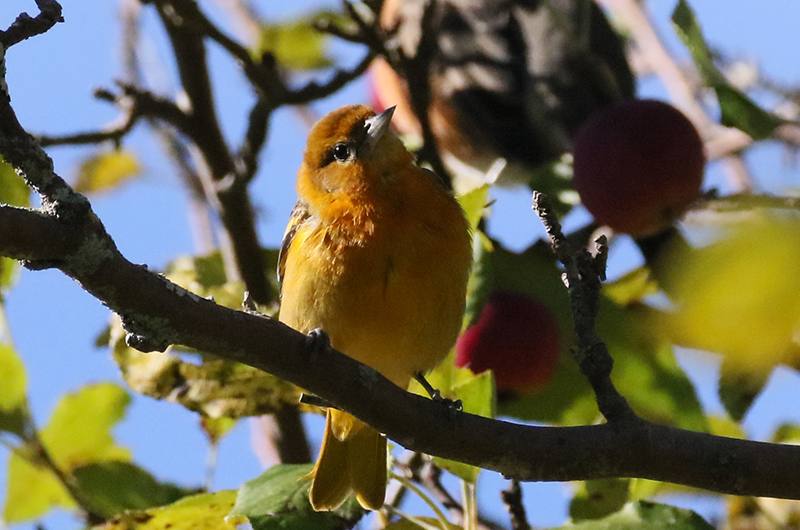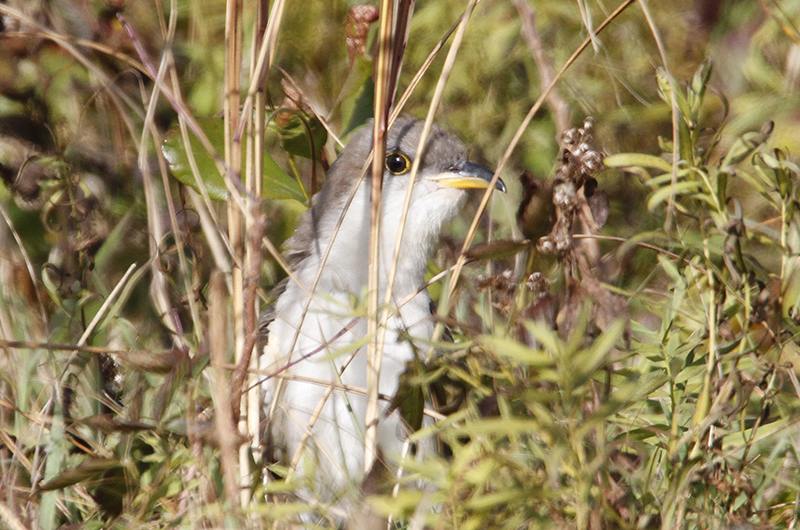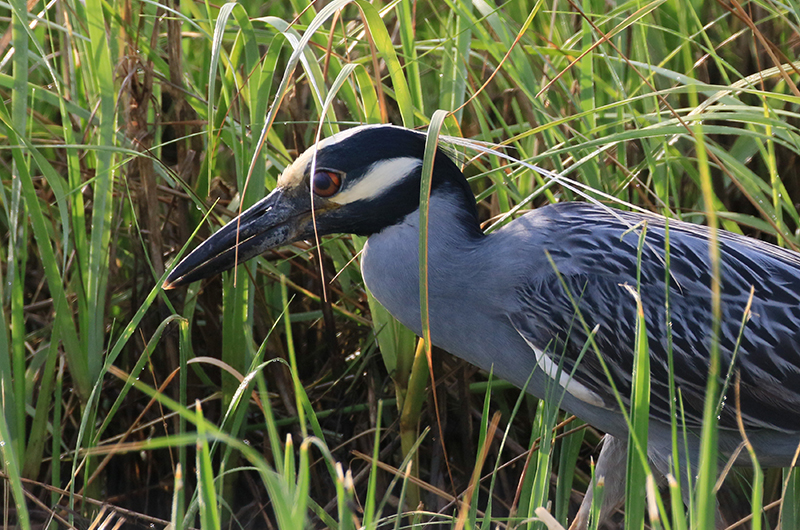At least eight ruby-throated hummingbirds visited Les and Terry Cutler’s feeders on August 21. It was difficult to count them because they zip around chasing each other so much! Such abundance is not surprising as they are at the peak of their southward migration in middle-to-late August. They are, of course, attracted to sugar-water feeders but be sure to look for them in your flower garden and in the wild, visiting brightly-colored flowers like the orange-flowered jewelweed. Hummers have also been observed by Stacy Hall, Vicki Bologna, Christy Edwards, Cynthia Bloomquist and Andrew Eppedio,
Also suddenly abundant are Baltimore orioles, six of which were hanging around at Tim Rush’s Edgartown feeders on August 23. Tami Dinkel saw some on August 20 and I have been hearing and seeing them at my house, Sheriff’s Meadow Sanctuary and Cedar Tree Neck. Their song at this time of the year is but mere snippets of their spring singing but it still is easily recognizable.
Other songbirds are also on the move – red-breasted nuthatches have been reported by Matt Pelikan in his yard on August 19. And Andrew Eppedio saw them in Ocean Heights on August 21 and at Great Rock Bight on Aug. 19. Maybe this will be an invasion year for these small, more northern cousins of the white-breasted nuthatches.
Songbird migration is increasing in intensity and will peak in early to middle-September. Brandon Reo heard a black-throated green warbler in Menemsha on August 23. Jason Flanders found a northern waterthrush that had hit a window on August 23 (unfortunately, it did not survive). On August 19, the highlights of Andrew and Merrill Eppedio’s visit to Great Rock Bight were a willow flycatcher and a warbling vireo. And a yellow-billed cuckoo was heard by Nancy Slate on August 22.
Bird Sightings
Adult bald eagles are always noteworthy. This week both Katherine May-Waite and Elizabeth Drew reported one hanging out along South Road near the Allen Farm on August 22. Also on the predator front, juvenile Cooper’s hawks were frequenting Anne Whiting and Sharon Simonin’s yards on August 23.
Shorebirds continue their abundance. Most notable perhaps is a flock of 15 least sandpipers seen in a very small salt marsh along Majors Cove at Felix Neck on August 24, spotted by myself, Wendy Culbert, Jane Culbert and Henry Olds. I do not remember ever seeing so many of them in one place before.
Also of special interest are the red knots observed on Norton Point by Andrew and Merrill Eppedio and Hans Goeckel on August 21 and by Lanny McDowell on August 23. Jeff Peters spotted one at Black Point Pond on August 18.
Little Beach produced two shorebirds of particular interest – Lanny McDowell’s white-rumped sandpiper on August 23 and the two juvenile western sandpipers I saw on August 20, which were also seen by Andrew and Merrill Eppedio on August 22.
There were two sightings of whimbrels this week, one by Warren and Iris Woessner at The Farm Institute on August 22 and another by Dorothy Wadlow on Cape Poge on August 20.
Matt Pelikan found a Forster’s tern on Black Point Pond on August 22, while a black tern was spotted over Menemsha Pond by Andrew and Merrill Eppedio that same day.
The more abundant shorebirds also continue to be reported, including plovers: semipalmated, black-bellied and piping, ruddy turnstones, sandpipers: sanderling, semipalmated short-billed dowitcher, willets, both greater and lesser yellowlegs, terns: least, common, and roseate terns, laughing gull, green heron, great egret, and great blue heron.
Yellow-crowned night-herons are also in the news. Luanne Johnson spotted one on the western portion of Lake Tashmoo on August 24, while Phil Edmundson spotted an immature at Sheriff’s Meadow Sanctuary on August 23
Andrew and Merrill Eppedio spotted four green-winged teals on West Tisbury’s Mill Pond on August 19.
And, last but not least, Rick Gilfillan sent along a photo of seven great egrets perched in trees near Dog Fish Bar on Aug. 23. Although we think of them as shorebirds, living along the shoreline and hunting for fish, they usually roost in trees at night. Why? Think about how many mammalian predators we have on the Island.
Robert Culbert is an ecological consultant with Nature Watch LLC living in Vineyard Haven.











Comments
Comment policy »